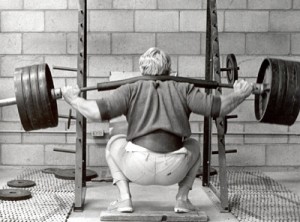
Recent Blog Posts
December 1, 2013
Goings on…
Finished! Yep, last week I completed data collection for my doctoral dissertation study. It is the first study to compare muscular adaptations (muscle hypertrophy and strength) between bodybuilding- and powerlifting-type routines in well-trained individuals. Preliminary results are really interesting. Can’t get into too much detail at this point but some findings were expected while others were not. The implications with respect to the strength-endurance continuum are significant and will certainly help to further our understanding of how to best structure routines for optimal muscular gains. I’ll have a lot more to say on this over the coming months, including some general observations about inter-individual responses that have important relevance to practical applications. Stay tuned.
In case you missed it, last week I wrote a rebuttal blog post to a journal review article by nutrtional researcher, Dr. John Ivy. In his review, Dr. Ivy challenged a previous paper I co-authored with Alan Aragon on nutrient timing, citing what I consider shaky evidence to support a tenuous position. My post was a point-by-point refutation of this evidence. As noted in my post, I respect Dr. Ivy’s body of work and consider him a fine researcher. In fairness, I emailed him a link to the post and offered the opportunity to write a counterpoint article on my site. As yet I’ve not received a response. If and when he replies, I will post his comments in their entirety.
Finally, here’s the lastest episode of the B&B Connection webcast. In this episode Bret and I discuss the science and art of tempo training. Topics include whether fast or slow lifts are better for strength, power and/or hypertrophy; whether there is a benefit to varying cadence; whether eccentric actions require a different cadence than concentric actions, and; whether “superslow” training has a place in a lfiting routine.
September 19, 2010
Review Article to Be Published in JSCR
I just received word that my review paper, “The Mechanisms of Muscle Hypertrophy and Their Application to Resistance Training” will be published in the October issue of the Journal of Strength and Conditioning Research. The abstract has been indexed in Medline at the link below:
The Mechanisms of Muscle Hypertrophy and Their Application to Resistance Training
More to come on this soon…
Stay Fit!
Brad
April 20, 2010
Strength Training and Metabolic Rate
I recently received an email response to one of my television appearances questioning my assertion that strength training helps to improve metabolism. As I responded to this individual, the research on the subject speaks for itself. Here is the lowdown…

First, there is a large body of evidence showing that resistance training has a significant effect on excess post–exercise oxygen consumption (EPOC)–far more than aerobic exercise (Burleson, et al. 1998; Gillette, et al. 1994). Osterburg and Melby (2000) found that an intense resistance training bout increased resting metabolic rate by 4.2% over a 16 hour period following exercise, which is quite substantial. More recently, Schuenke and colleagues (2002) showed that EPOC was significantly elevated 38 hours after resistance training, highlighting its importance in reducing body fat.
Longer term studies show a significant impact of resistance training on metabolic rate. Cambell and colleagues reported an increase in resting metabolic rate of approximately 6.8% following 12 weeks of strength training. This translated into an additional 105 calories burned per day. A study by Pratley and colleagues (1994) came to a similar conclusion on the topic, showing a 7.7% increase in metabolic rate after a four month strength training protocol. And more recently, Hunter, et al. (2000) found that 26 weeks of regimented strength training resulted in a 6.8% increase in resting energy expenditure in elderly adults. Realize, too, that these studies examined the metabolic response in older individuals–younger subjects who strength train with higher intensities of effort are bound to see even greater results.
Finally, there is a substantial body of evidence that strength training is essential in promoting long term weight management (Bryner, et al 1999; Donnelly, et al. 1993; Ryan, et al, 1995). A recent study by Bea and colleagues (2009) gave further credence to this, showing that both frequency of resistance training and the amount of weight lifted were inversely associated with weight gain (i.e. those who exercised more and lifted more had lower body weights). On the whole, those who lifted were significantly leaner than those who didn’t.
Bottom line is that strength training confers a significant metabolic effect. For those seeking to lose body fat, it is an indispensable component of any exercise program. The research is clear: lift to lose!
Stay Fit!
Brad
References:
Bea JW, Cussler EC, Going SB, Blew RM, Metcalfe LL, Lohman TG. Resistance Training Predicts Six-Year Body Composition Change in Postmenopausal Women. Med Sci Sports Exerc. 2009 Dec 14.
Bryner Rw, et al. Effects of resistance vs. aerobic training combined with an 800 calorie liquid diet on lean
body mass and resting metabolic rate. J Am Coll Nutr. 1999 Apr;18(2):115-21.
Burleson, M.A. et al. 1998. Effect of weight training exercise and treadmill exercise on elevated post-exercise oxygen consumption. Medicine & Science in Sports & Exercise, 30, 518-22.
Campbell, W., M. Crim, V. Young and W. Evans. Increased energy requirements and changes in body composition with resistance training in older adults. American Journal of Clinical Nutrition 60: 167-175, 1994
Donnelly JE, et al. Muscle hypertrophy with large-scale weight loss and resistance training. Am J Clin Nutr. 1993 Oct;58(4):561-5.
Gillette CA, Bullough RC, Melby CL. Postexercise energy expenditure in response to acute aerobic or resistive exercise. Int J Sport Nutr. 1994 Dec;4(4):347-60.
Hunter GR, Wetzstein CJ, Fields DA, Brown A, Bamman MM. (2000). Resistance training increases total energy expenditure and free-living physical activity in older adults. J Appl Physiol. 89(3):977-84.
Osterberg KL, Melby CL. Effect of acute resistance exercise on postexercise oxygen consumption and resting metabolic rate in young women. Int J Sport Nutr Exerc Metab. 2000 Mar;10(1):71-81.
Pratley, R., B. Nicklas, M. Rubin, J. Miller, A. Smith, M. Smith, B. Hurley and A. Goldberg. (1994). Strength training increases resting metabolic rate and norepinephrine levels in healthy 50- to 65-year-old men. Journal of Applied Physiology Jan;76(1):133-7.
Ryan AS, Pratley RE, Elahi D, Goldberg AP. Resistive training increases fat-free mass and maintains RMR despite weight loss in postmenopausal women. J Appl Physiol. 1995 Sep;79(3):818-23.
Schuenke MD, Mikat RP, McBride JM. Effect of an acute period of resistance exercise on excess post-exercise oxygen consumption: implications for body mass management. Eur J Appl Physiol. 2002 Mar;86(5):411-7.
February 4, 2010
Are Full Squats Bad for Your Knees?
I recently was asked to write a paper for the NSCA Hot Topic series, and decided to address one of the most controversial subjects in the fitness field: namely, are full squats bad for your knees? As I detailed in the article, the answer is no, deep squats do not pose increased risk of injury to the knees *provided* you have no existing knee issues. Without question, deep squats may be contraindicated for those with knee pathology depending on the extent of the injury (it should be noted that any exercise may contraindicated because of injury). If you fall into this category, a qualified physician specializing in sports medicine should be able to assess what you can and can’t do. Otherwise, squat depth should not be an issue from an injury perspective. In fact, the deeper range of the squat is actually protective of many of the knee structures!

Assuming you have healthy knee function, what you should in fact consider with respect to squat depth are your goals. Deep squats have relevance to various sports, as well as many activities of daily living. These are powerful reasons why you would be well served by squatting as low as possible, at least on some of your sets. What’s more, glute involvement increases the lower you go in a squat. This means that if you want to maximize the development of your butt, then deep squats are highly beneficial. On the other hand, quadriceps development is greatest squatting to parallel. So if you are most concerned with developing your frontal thighs, deep squats might not be a necessity.
The bottom line is, don’t be afraid to squat low as long as you don’t have any existing knee problems. Make a decision based on your goals, not fear of injury. If you’re interested in reading about the science on the topic, you can check out my Hot Topic article at the link below.
The Biomechanics of Squat Depth
Stay Fit!
Brad
February 2, 2010
Strength Training and Weight Loss
In previous blog posts, I’ve addressed the importance of resistance training in reducing body fat and maintaining weight loss. You may remember that this was a hot topic over the summer in my rebuttal to the Time Magazine article on whether exercise is beneficial for losing weight. Now comes yet more evidence to back up these claims.

In a study published in the prestigious journal Medicine and Science in Sports and Exercise, a research group led by Jennifer Bea evaluated the effects of strength training on 122 postmenopausal women over the course of a 6-year period. All of the women had been previously sedentary. At the beginning of the study, 65 of the women were placed in an exercise program consisting of various strength training training exercises including squats and presses. A year into the study, 32 of the remaining non-exercisers were placed on the exercise program, leaving 25 of the women to serve as controls who did not exercise throughout the entire period studied. What was the outcome? As you may have guessed, strength training had a positive effect on weight management. Specifically, both exercise frequency and the amount of weight lifted were inversely associated with weight gain (i.e. those who exercised more and lifted more had lower body weights). On the whole, those who lifted were significantly leaner than those who didn’t.
For anyone who has read this blog, these results should not come as a surprise. The metabolic benefits attributed to lifting weights have been well documented. Not only is there a significant caloric cost associated with strength training (provided rest intervals are limited and sets are sufficiently challenging), but it also increases excess post-exercise oxygen consumption (i.e. the “afterburn”) so that calorie burning continues for up to 38 hours or more after a workout. Further, muscle itself is a metabolically active tissue that serves to keep your metabolism stoked round the clock. By increasing muscle development, strength training indirectly promotes better weight management.
Bottom line: An exercise program aimed at weight loss should always have a strength training component. While aerobic exercise certainly will help to expedite fat loss, nothing replaces lifting weights for enhancing fat burning and, more importantly, keeping the weight off over the long term. Lift to lose!
Stay Fit!
Brad
Reference:
Bea JW, Cussler EC, Going SB, Blew RM, Metcalfe LL, Lohman TG. Resistance Training Predicts Six-Year Body Composition Change in Postmenopausal Women. Med Sci Sports Exerc. 2009 Dec 14.





 Entries (RSS)
Entries (RSS)



